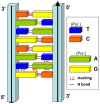What Is life? Rethinking Biology in Light of Fundamental Parameters
- PMID: 38541606
- PMCID: PMC10971028
- DOI: 10.3390/life14030280
What Is life? Rethinking Biology in Light of Fundamental Parameters
Abstract
Defining life is an arduous task that has puzzled philosophers and scientists for centuries. Yet biology suffers from a lack of clear definition, putting biologists in a paradoxical situation where one can describe at the atomic level complex objects that remain globally poorly defined. One could assume that such descriptions make it possible to perfectly characterize living systems. However, many cases of misinterpretation put this assumption into perspective. In this article, we focus on critical parameters such as time, water, entropy, space, quantum properties, and electrostatic potential to redefine the nature of living matter, with special emphasis on biological coding. Where does the DNA double helix come from, why cannot the reproduction of living organisms occur without mutations, what are the limitations of the genetic code, and why do not all proteins have a stable three-dimensional structure? There are so many questions that cannot be resolved without considering the aforementioned parameters. Indeed, (i) time and space constrain many biological mechanisms and impose drastic solutions on living beings (enzymes, transporters); (ii) water controls the fidelity of DNA replication and the structure/disorder balance of proteins; (iii) entropy is the driving force of many enzymatic reactions and molecular interactions; (iv) quantum mechanisms explain why a molecule as simple as hydrocyanic acid (HCN) foreshadows the helical structure of DNA, how DNA is stabilized, why mutations occur, and how the Earth magnetic field can influence the migration of birds; (v) electrostatic potential controls epigenetic mechanisms, lipid raft functions, and virus infections. We consider that raising awareness of these basic parameters is critical for better understanding what life is, and how it handles order and chaos through a combination of genetic and epigenetic mechanisms. Thus, we propose to incorporate these parameters into the definition of life.
Keywords: biology; electrostatic potential; origin of life; quantum biology; time; water.
Conflict of interest statement
The authors declare no conflicts of interest.
Figures







Similar articles
-
Planning Implications Related to Sterilization-Sensitive Science Investigations Associated with Mars Sample Return (MSR).Astrobiology. 2022 Jun;22(S1):S112-S164. doi: 10.1089/AST.2021.0113. Epub 2022 May 19. Astrobiology. 2022. PMID: 34904892
-
Chronoastrobiology: proposal, nine conferences, heliogeomagnetics, transyears, near-weeks, near-decades, phylogenetic and ontogenetic memories.Biomed Pharmacother. 2004 Oct;58 Suppl 1:S150-87. doi: 10.1016/s0753-3322(04)80025-8. Biomed Pharmacother. 2004. PMID: 15754855
-
Life and living beings under the perspective of organic macrocodes.Biosystems. 2021 Aug;206:104445. doi: 10.1016/j.biosystems.2021.104445. Epub 2021 May 24. Biosystems. 2021. PMID: 34033908 Review.
-
Physical Biology : challenges for our second decade.Phys Biol. 2014 Jun;11(3):030201. doi: 10.1088/1478-3975/11/3/030201. Epub 2014 Apr 15. Phys Biol. 2014. PMID: 24732666
-
Consciousness, biology and quantum hypotheses.Phys Life Rev. 2012 Sep;9(3):285-94. doi: 10.1016/j.plrev.2012.07.001. Epub 2012 Jul 10. Phys Life Rev. 2012. PMID: 22925839 Review.
Cited by
-
Glutamate, Gangliosides, and the Synapse: Electrostatics at Work in the Brain.Int J Mol Sci. 2024 Aug 6;25(16):8583. doi: 10.3390/ijms25168583. Int J Mol Sci. 2024. PMID: 39201269 Free PMC article. Review.
-
Cholesterol-Dependent Serotonin Insertion Controlled by Gangliosides in Model Lipid Membranes.Int J Mol Sci. 2024 Sep 23;25(18):10194. doi: 10.3390/ijms251810194. Int J Mol Sci. 2024. PMID: 39337677 Free PMC article.
References
-
- Schrodinger E. What is Life? The Physical Aspect of the Living Cell. Cambridge University Press; Cambridge, UK: 1951.
-
- Hecht E. Understanding energy as a subtle concept: A model for teaching and learning energy. Am. J. Phys. 2019;87:495–503. doi: 10.1119/1.5109863. - DOI
Publication types
LinkOut - more resources
Full Text Sources

